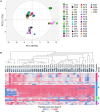Evaluation of the Major Seed Storage Proteins, the Conglutins, Across Genetically Diverse Narrow-Leafed Lupin Varieties
- PMID: 35634370
- PMCID: PMC9136412
- DOI: 10.3389/fnut.2022.842168
Evaluation of the Major Seed Storage Proteins, the Conglutins, Across Genetically Diverse Narrow-Leafed Lupin Varieties
Abstract
Lupin seeds have an excellent nutritional profile, including a high proportion of protein and dietary fiber. These qualities make lupin seeds an ideal candidate to help meet the growing global demand for complementary sources of protein. Of consequence to this application, there are nutritional and antinutritional properties assigned to the major lupin seed storage proteins-referred to as α-, β-, δ- and γ-conglutins The variation in the abundance of these protein families can impact the nutritional and bioactive properties of different lupin varieties. Hence, exploring the conglutin protein profiles across a diverse range of lupin varieties will yield knowledge that can facilitate the selection of superior genotypes for food applications or lupin crop improvement. To support this knowledge generation, discovery proteomics was applied for the identification of the 16 known conglutin subfamilies from 46 domestic and wild narrow-leafed lupin (NLL) genotypes. Consequently, the diversity of abundance of these proteins was evaluated using liquid chromatography-multiple reaction monitoring-mass spectrometry (LC-MRM-MS). This comparative study revealed a larger variability for the β- and δ-conglutin content across the lines under study. The absence/lower abundance of the β2- to β6-conglutin subfamilies in a subset of the domesticated cultivars led to substantially lower overall levels of the allergenic β-conglutin content in these NLLs, for which the elevation of the other conglutin families were observed. The diversity of the conglutin profiles revealed through this study-and the identification of potential hypoallergenic genotypes-will have great significance for lupin allergic consumers, food manufactures as well as grain breeders through the future development of lupin varieties with higher levels of desirable bioactive proteins and lower allergen content.
Keywords: LC-MRM-MS; Lupinus angustifolius; conglutin; legume; narrow-leafed lupin; plant-based protein; proteomics.
Copyright © 2022 Tahmasian, Juhász, Broadbent, Nye-Wood, Le and Colgrave.
Conflict of interest statement
The authors declare that the research was conducted in the absence of any commercial or financial relationships that could be construed as a potential conflict of interest.
Figures



References
-
- McKinsey & Company. Alternative Proteins: The Race for Market Share is On. (2019). Available online at: https://www.mckinsey.com/industries/agriculture/our-insights/alternative... (accessed December 22, 2021)
-
- Arnoldi A, Boschin G, Zanoni C, Lammi C. The health benefits of sweet lupin seed flours and isolated proteins. J Funct Foods. (2015) 18:550–63. 10.1016/j.jff.2015.08.012 - DOI
LinkOut - more resources
Full Text Sources

